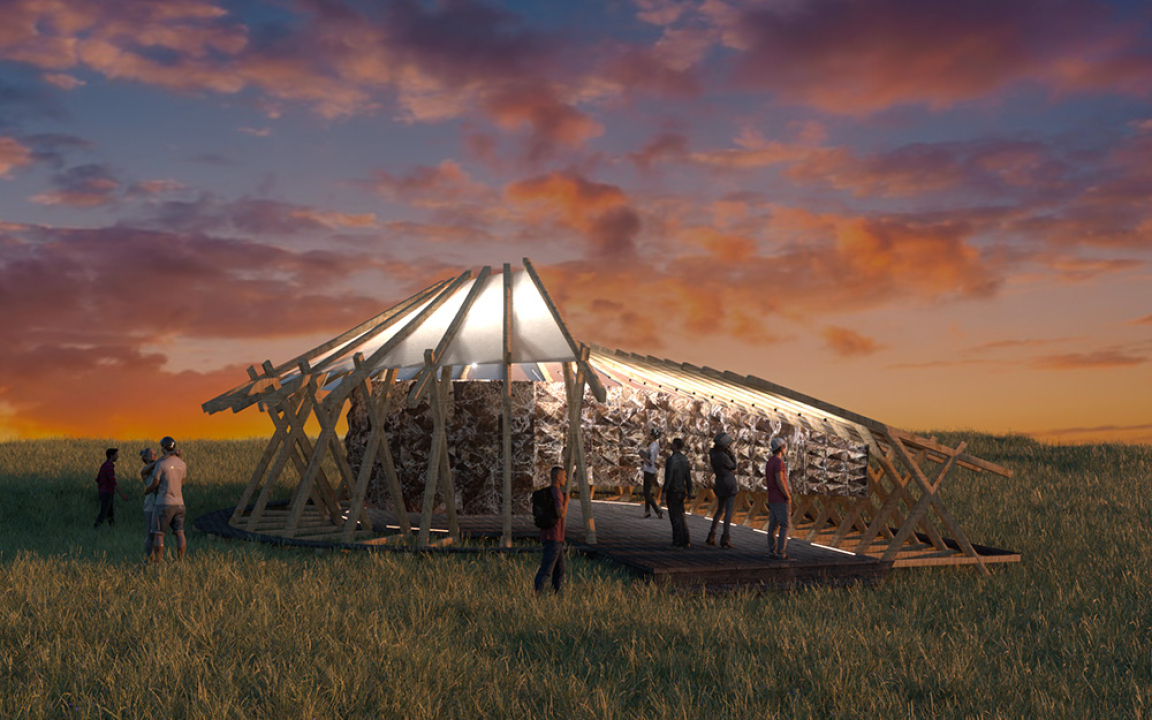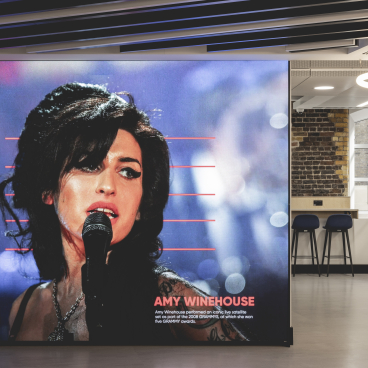Glastonbury Festival’s new Hayes Pavilion marks the start of a fungi-based future for creative industries.

Glastonbury Festival's new Hayes Pavilion celebrates the 10th anniversary and new evolution for its Silver Hayes field. Its debut art project, 6 °, will be open to festival goers from 22nd - 25th June 2023.
The first of its kind, Hayes Pavilion will harness the interconnected power of mushroom roots - the extraordinary underground network known as mycelium - and investigate the potential adoption of this biomaterial in creative industries.
Inspired by its potential as a new industrial material, a selection of multi-disciplinary practitioners, from film, TV, set design and educational institutes such as Central St Martins, the Royal College of Art and Bath Spa University, will explore artistic expression, creative possibilities and investigate the potential of mycelium.
The project aims to demonstrate the opportunity to move away from environmentally impacting materials to a more sustainable fungi future. When mycelium is fed with agricultural waste, it forms a construction material, such as polystyrene, foam and plastics, but is entirely organic and compostable. In the 6 week period leading up to the installation at Glastonbury Festival, this creative collective will test, manipulate and challenge what is possible with mycelium as a practical material.
Friends of Material Source Studio, Biohm are the designers and manufacturers behind the mycelium tiles used to construct the pavilion. Eager to discover more about their involvement, we caught up with the team to hear about Glastonbury’s biobased revolution.
What makes mycelium an advantageous material for building and construction?
“Mycelium composite materials have a variety of qualities that make it great for construction and insulating applications, including strenghth, thermal insulating, durability and acoustic properties. It is a breathable product which contains negligible amounts of Volatile Organic Compounds (VOC) and improves indoor air quality. It sequesters carbon by locking in agricultural waste into a composite material. It is biodegradable at the end of life and remanufacturable.”
How do you think the Hayes Pavilion will spur biobased change in other creative industries?
“We hope our involvement in the Hayes Pavilion will inspire the use of biotechnology and biobased materials across the construction and creative industries. In the creative industry, where temporary structures are very common, and often made from petrochemical-based materials, we hope to see a move towards more regenerative materials that can give back to the biosphere at end of life rather than contaminating it.”
What can we expect to see from you guys next at Biohm?
“Biohm's biotechnologies, which are patented in almost 60 countries, are being developed into high-performance materials, products and systems for leading multinationals and global players to license and deliver at scale.”

On site at Glastonbury, the pavilion will showcase these findings in an exhibition that journey’s through simple 2-dimensional forms to innovative 3-dimensional approaches, which will push the creative limits of the mycelium material. The magical mycelium pavilion will also play host to specially commissioned immersive sound art compositions by academic and musician, Brian d'Souza (Auntie Flo) and rising star, Or:la, in collaboration with harpist, Roísín Berkeley.
The music will highlight the ties between people and places that emulate the connectivity of mushrooms. The creative learnings from the mycelium project at the Hayes Pavilion, as well as carbon data collection, will be published in a report after Glastonbury, the aim is to give the wider industry the findings and recommendations on best practice for future creatives wanting to interact with the biomaterial.


A short film will also be published documenting the journey. This video team will include training placements through Big Team CIC. Big Team is Team Love’s inner city youth outreach and engagement CIC, that creates both opportunity within their business and the festival industry. The new Pavilion forms a central part of Silver Hayes' 2023 evolution story.
The iconic electronic music field will unveil a new iteration of the area, driven by cutting edge ideas and future technologies. 2023 will also see Silver Hayes introduce a stage for urgent debate on music culture and beyond titled The Information, and unveil creative re-imagining of three iconic stages - culminating with the reveal of THE LEVELS, Glastonbury’s newest open air nightclub offering.
The Hayes Pavilion will be a returning platform for artistic research and development at Glastonbury each year, looking at how festivals can be at the forefront of new ideas, materials and products which will potentially help society move towards a more sustainable future. The project is led by Silver Hayes’ Team Love and designed by Simon Carroll from Temple Design Studio in association with Big Team CIC, Glastonbury Festival and manufacturer, Biohm & Grown Bio. It is also supported using public funding by the National Lottery through Arts Council England.
Emily Eavis, co-organiser of Glastonbury Festival comments: "We're so excited to be bringing this groundbreaking installation to this year's Festival, and I hope visitors will flock to Silver Hayes to check out the incredible, sustainable potential of mycelium at the Pavilion.”




